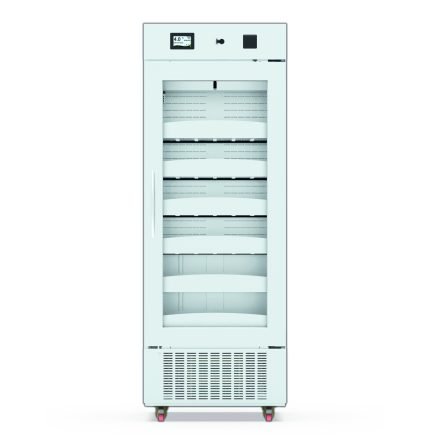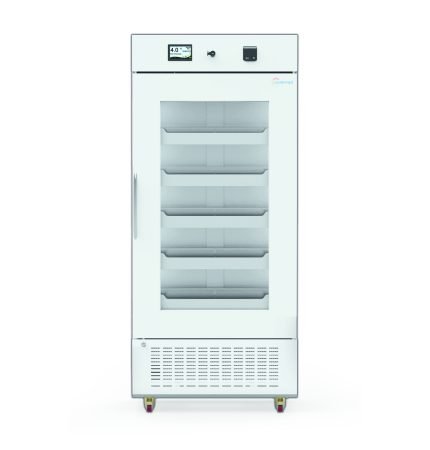Showing all 4 results
In the sophisticated domain of medical science and technology, the significance of the blood bank refrigerator cannot be overstated. It plays a critical role in preserving a paramount life-saving resource: blood. At this point, the difference between a blood bank refrigerator and a normal refrigerator is significant. A blood bank refrigerator is specifically designed to maintain a stable temperature range between 2°C and 6°C, crucial for preserving the viability of blood and blood products. It includes features such as precise temperature control, alarm systems, and backup power to ensure constant monitoring and safety. In contrast, a normal refrigerator does not offer the same level of precision or reliability required for the critical storage of blood, making it unsuitable for medical applications. The very essence of this specialized refrigeration system hinges upon unwavering accuracy, consistent reliability, and the highest standards of safety. As medical interventions and research evolve rapidly, there is an inherent demand for state-of-the-art equipment that can guarantee optimal results. Coolermed stands at the forefront of this technological vanguard. At Coolermed, we comprehend the profound nature of our duty in the medical freezers. It is not merely an exercise in maintaining temperature but a meticulous endeavor to safeguard life by preserving each blood unit.
How Do You Store Blood?
The storage of blood is a meticulous process crucial for maintaining its viability for transfusions. Blood must be stored at precise temperatures to ensure its safety and efficacy. Whole blood and red blood cells are kept at 1-6°C in specialized blood bank refrigerators equipped with alarms and monitoring systems. These conditions help slow down metabolic activities, reducing bacterial growth and preserving blood cells. Blood mixed with anticoagulants can be stored up to 42 days before transfusion. Platelets, stored at 20-24°C, must be used within 5 days, while plasma can be frozen for up to a year at -18°C or colder. For transportation, outdoor coolers maintain the necessary blood storage temperature. Adhering to strict protocols, including regular temperature monitoring and hygienic handling, ensures the safe preservation of blood, essential for a reliable and effective blood supply.
The Function of Blood Bank Refrigerator
Blood bank freezers play a critical role in the preservation and safety of blood and blood components, ensuring they are kept at optimal conditions until they are needed for transfusions. These specialized blood bank refrigerators are designed to maintain a consistent and precise temperature, which is crucial for the longevity and usability of the stored blood.
Maintaining Optimal Temperatures
One of the primary functions of a blood bank freezer is to maintain the normal temperature for a blood bank storage. This temperature is typically set at 4°C (39.2°F), which is considered the optimal temperature for preserving red blood cells. Maintaining this temperature prevents the growth of bacteria and other pathogens that could compromise the safety of the blood. The temperature for storing Fresh Frozen Plasma (FFP) in a blood bank is crucial, as FFP must be stored at -18°C (-0.4°F) or lower to preserve its clotting factors and overall quality. Blood bank refrigerators, equipped with precise temperature control, alarms, and monitoring systems, ensure the safety and viability of stored blood and blood products. These specifications, along with the refrigerator’s capacity and energy efficiency, significantly influence the overall price. Investing in a high-quality blood bank storage is essential for compliance with regulatory standards and ensuring a reliable blood supply for patient safety.
Blood Storage Temperature Range and Control
The blood bank refrigerator temperature range is another crucial aspect of these freezers. They are usually set to maintain temperatures between 1°C and 6°C (33.8°F to 42.8°F). This range ensures that the blood and blood components remain viable and safe for transfusion. Advanced blood bank freezers come equipped with temperature monitoring systems that provide real-time data and alarms to alert staff if the temperature deviates from the set range.
Storage of Blood for Transfusions
Another critical function of blood bank refrigerators is to ensure that the blood is stored at the correct temperature before transfusion. So, what temperature should blood transfusion be kept at in the fridge? Blood intended for transfusion must be stored at temperatures between 2°C and 6°C (35.6°F to 42.8°F). This temperature range is essential to preserve the integrity of the blood cells and to prevent hemolysis or other forms of degradation that could affect the efficacy of the transfusion.
Key Features of Modern Blood Bank Refrigerators
Modern blood bank refrigerators stand out as examples of innovation and precision in the continuously advancing realm of medical technology. These advanced systems have transcended the confines of traditional refrigeration, offering features tailored explicitly to the rigorous demands of blood preservation.
- Precision Temperature Control: Maintaining a consistent temperature is one of the most critical factors in blood preservation. Modern blood bank fridges are equipped with advanced sensors and feedback mechanisms to ensure that the temperature remains within the narrow, specified range, regardless of external conditions.
- Efficient Blood Storage Cabinet Design: The design and layout of the blood storage cabinet in these refrigerators prioritize ease of access and efficient space utilization. This ensures that blood units are systematically organized, reducing the risk of errors during retrieval.
- Enhanced Safety Mechanisms: Given the invaluable nature of the stored resource, these refrigerators have heightened security features. From door alarms to backup power systems, the goal is to protect the contents from external threats or failures.
Energy Efficiency: Recognizing the global shift towards sustainability, modern blood bank fridges are designed to consume minimal energy without compromising on their primary function of blood preservation. - Integrated Monitoring Systems: With the aid of technology, these refrigerators now offer real-time monitoring solutions. Healthcare professionals can remotely observe and adjust the conditions inside the fridge, ensuring the highest standards of safety and reliability.
The features of a modern blood bank storage, such as the efficient blood storage cabinet design and advanced temperature control mechanisms, underscore the paramount importance of precise and reliable blood storage. At Coolermed, we acknowledge this evolving need and continually strive to incorporate these advanced features, making us a trusted name in the field.
Selecting the Right Blood Bank Refrigerator
The decision to acquire a blood bank storage necessitates a deep understanding of various aspects to ensure that the investment aligns with immediate needs and anticipates future requirements. One pivotal question often posed is, “How long can blood be stored in the refrigerator?” The answer influences the type and capabilities of the refrigerator needed. Typically, whole blood and red cells can be refrigerated for up to 42 days, but this can vary depending on the specific components and conditions. Next, the consideration of mobility comes into play. A portable blood refrigerator is vital for certain operations, especially for mobile blood drives or emergencies where stationary units might not be feasible. These portable units must maintain the same stringent temperature standards as their stationary counterparts.
Furthermore, while refrigerators focus on keeping blood cool, there are instances where deep freezing is necessary. A blood bank freezer is designed to store certain blood components, like plasma, for up to a year or even longer. Knowing how to store blood in refrigerators and freezer models and understand the distinct requirements for each component. Budgeting also plays a key role. Blood bank refrigerator prices vary widely based on size, features, and brand reputation. Balancing budget constraints with quality and longevity is imperative, ensuring the chosen device meets all regulatory and operational standards. At Coolermed, you can explore a range of economically efficient solutions without compromising on quality. We offer diverse units, all designed to fit various budgetary frameworks seamlessly.
Blood Bank Refrigerator Price
Blood bank freezers are essential for medical facilities, ensuring the safe storage of blood and blood products like plasma and platelets at optimal temperatures. The price of a blood bank refrigerator can vary based on its uses and specifications. Typically, these refrigerators are designed to maintain a stable temperature between 2°C and 6°C, preserving the quality and viability of stored blood. Key specifications influencing the price include storage capacity, temperature control accuracy, alarm systems, and energy efficiency. Advanced models may offer additional features like digital monitoring, enhanced insulation, and backup power systems, which can also impact the cost. When choosing a blood bank refrigerator, it’s important to consider the specific needs of your facility to ensure compliance with regulatory standards and support emergency preparedness. Investing in a high-quality one is crucial for maintaining a reliable blood supply and ensuring patient safety. To achieve this, you can consult Coolermed.






